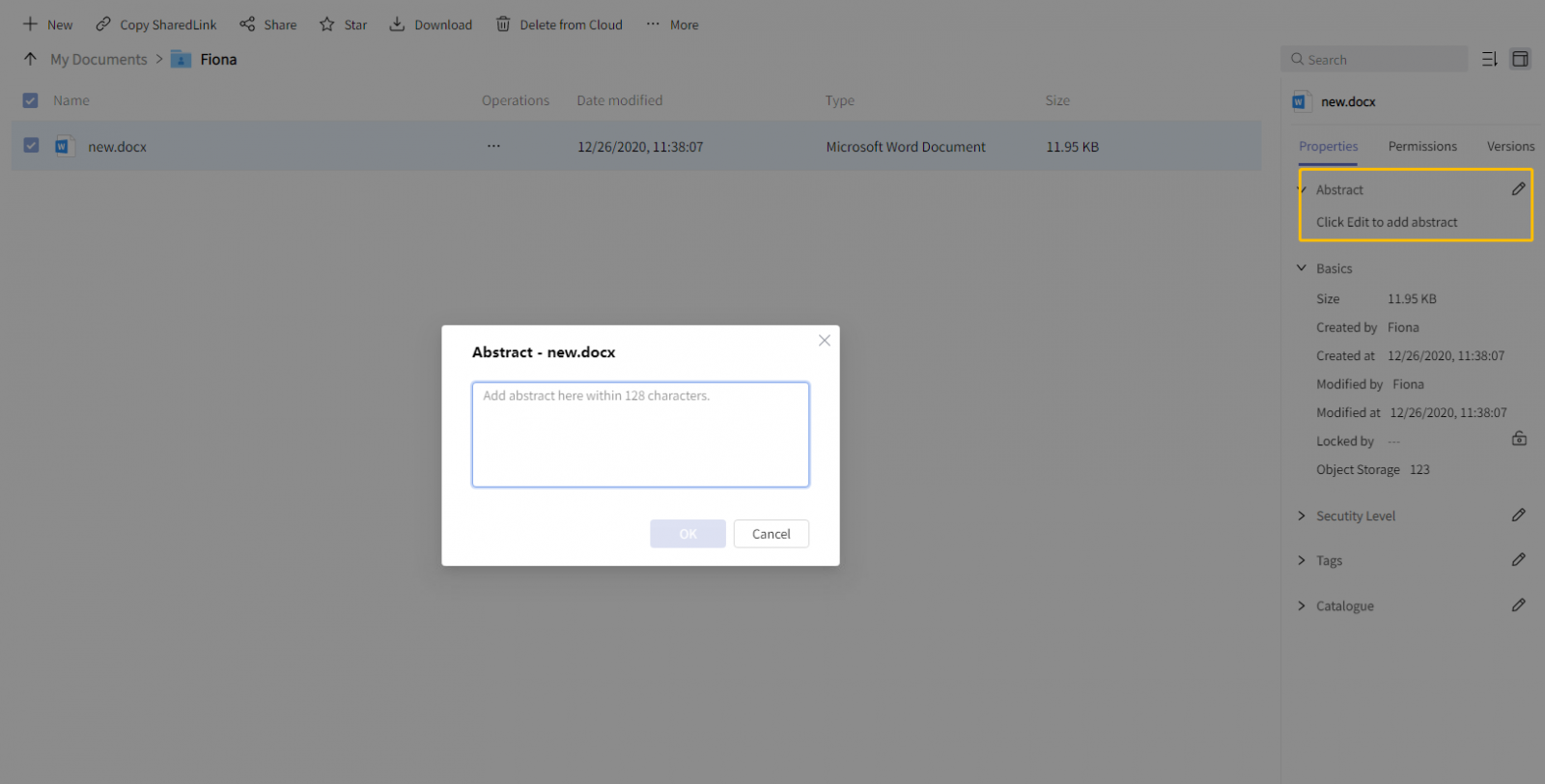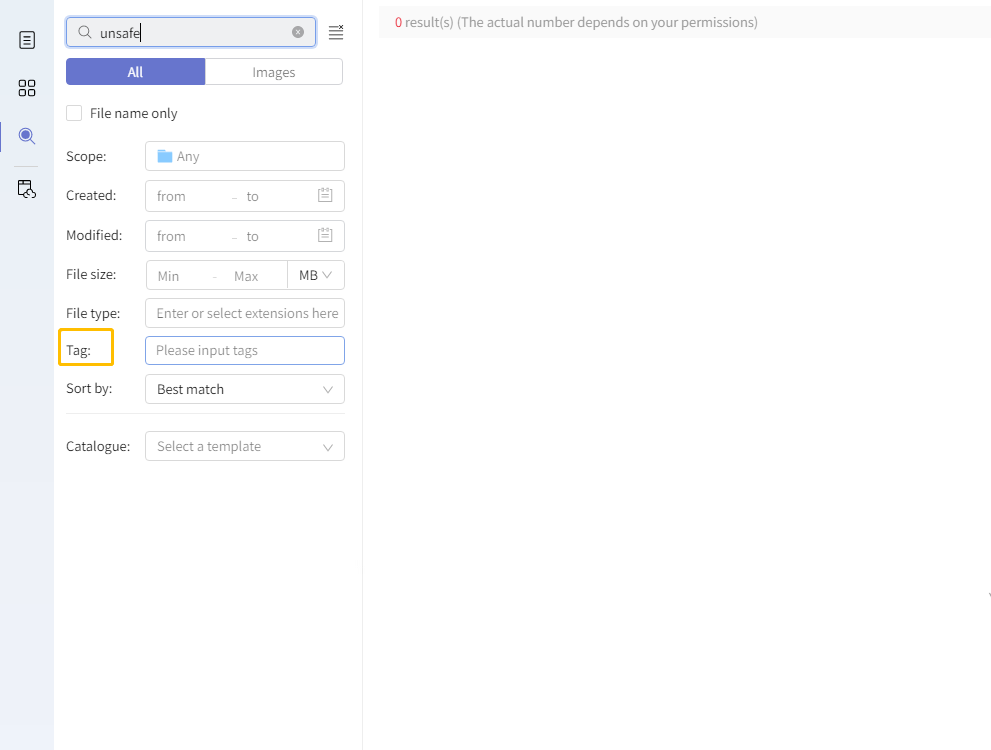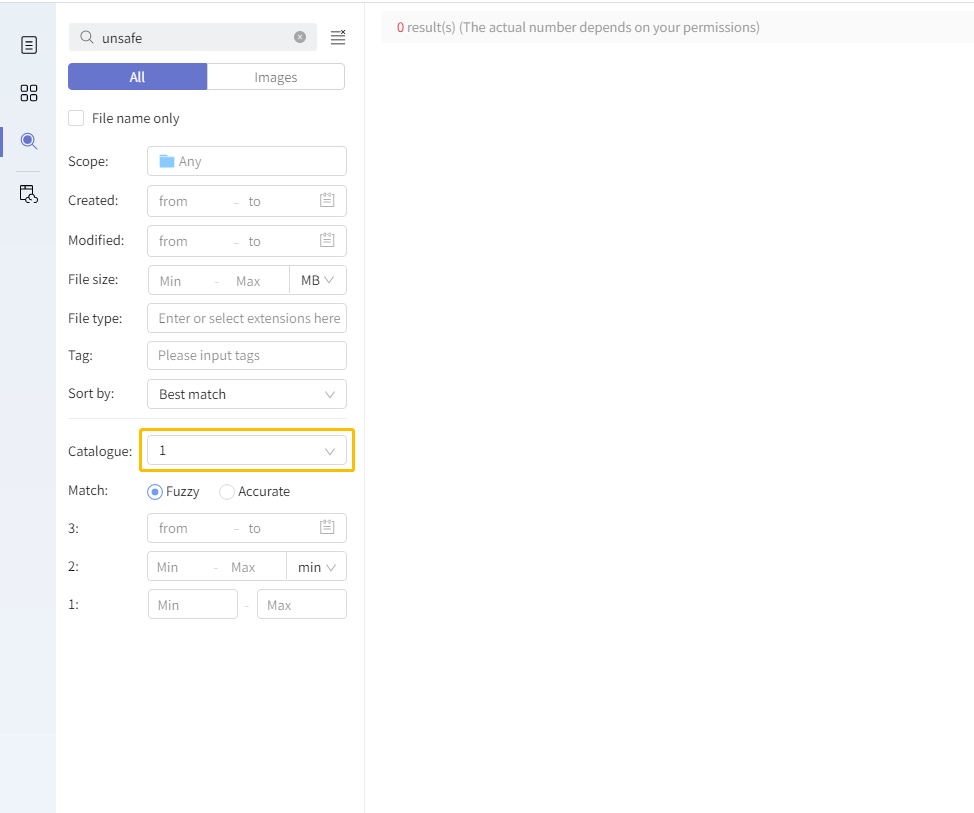Select a file and users can view its profile including the property and version.
In the file property bar, users can view file property (size, created by, created at, modified by, modified at, locked by, and stored on), security level, Tag, and Catalogue.AnyShare allows users to view the owner of a file and who is permitted to access it. There are 9 fine granular permission options including Display/Read/Modify/Create/Delete/Deny/Owner.
The remainder will focus on abstract, tag, and catalog.
Abstract
Abstracts in AnyShare
An abstract is a key element of a file and a summary of its content.
AnyShare performs the function of auto content analysis against files uploaded by users to extract abstract. Users can edit and update the abstract as well. However, it is only supported that adding and editing abstracts towards files. Supported file types: text and image (.jpg, .png, and .bmp).
Work with Abstract
With the file summary, manual and auto abstract addition can improve search preciseness. The intelligent image recognition system can produce tags and abstracts to search for pictures by text.
Use Abstract
- How do you Add Abstracts?
- Manual tags addition: The owner of a file or the users who are permitted to modify a file can add abstracts in the rich client. Select a file and click on [Edit] on the document infobar at the right side, users will see the pop-box and can input abstracts with the length being less than 128 characters. Click on [OK] and abstracts will be successfully added.
- Auto tags addition: Administrators need to deploy the Metadata Service and install the Full-Text Search Service in the Deployment Console first. After that, when users upload files to the client, AnyShare can recognize the file content and add abstracts to it.

- How do you view abstracts?
Select a file and click on the abstract dropdown box on the document infobar, and users will see the added abstracts of files. Users can also click on [Edit] on the document infobar at the right side and the text box popped would showcase the added abstracts.
- How do you edit abstracts?
The owner of a file or the users who are permitted to modify a file can edit and modify the abstracts. Select a file and click on [Edit] on the document infobar at the right side, users will see the pop-box for editing abstracts and the abstract text box will show extant abstracts. Modify or edit them then click on [OK] and abstracts will be successfully added.
- How do you delete abstracts?
The owner of a file or the users who are permitted to modify a file can add the abstracts. Select a file and click on [Edit] on the document infobar at the right side, users will see the pop-box for editing abstracts and the abstract text box will show extant abstracts. Clear the content then click on [OK] and abstracts will be successfully added.
- How do you search by abstracts?
Search by abstract and users will get files and pictures containing the abstract field searched. Click on [Search] and go to the search page, users can input keywords into the search box, AnyShare will present the abstract information of the file whose abstract field contains the input keywords, and the matched keywords will be highlighted.
Tag
Tags in AnyShare
Tagging equals marking. A tag is usually made up of several concise words for marking the taxonomy or content of a file. It is convenient for users to classify, retrieve, and manage files by the manual or the automatic tag addition.
Work with Tag
- Manually tagging for quick search There must be some pictures, audio, and video fields that are difficult to be searched. If users manually add tags to them, it will be convenient for later use by searching by tag directly.
- Smart content recognition for auto tags addition AnyShare can automatically recognize file content and add tags to it to help users efficiently organize file content.
- How do you add tags
- Manually tagging: The owner of a file/folder or the users permitted to modify a file/folder can add the tags manually in the rich client. Select a file/folder and click on [Edit] and users can input tags into the text box in the pop-up box, and AnyShare will automatically retrieve any matched tags. Pick one and AnyShare will automatically add it to the text box. Then users need to click [Add] to complete tagging. The number of tags added is changed by administrators and ruled that the default is 30 but it can be 100. If the same tag is added, the order of the tag list will remain unchangeable. Moreover, AnyShare allows bulk-adding tags to a file/folder.
- Auto tags addition: Administrators need to deploy the Metadata Service and install the Full-Text Search Service in the Deployment Console first. After that, when users upload files in the client, AnyShare can recognize the file content and add Tag to it. There will be 10 tags produced by default and 5 added automatically. Delete one tag and another one will be automatically populated. Till now, except for image, audio and video files, and zip package, common-used Office documents and files with extensions such as .txt, .PDF, and . HTML can be automatically added to tags.
- How do you view tags?
Select a file/folder and click on the right-side dropdown box of tags on the file infobar, and users will see the added tags.
- How do you edit tags?
The owner of a file/folder or the users who are permitted to modify a file/folder can edit and modify the tags. Select a file/folder and click on the file infobar to unfold tags, and users can click on [Edit] after selecting the tags they want to modify or update.
- How do you delete tags?
The owner of a file/folder or the users who are permitted to modify a file/folder can delete the tags. Select a file/folder and click on the file infobar to unfold tags, and users can click on [Edit] after selecting the tags they want to modify or update.
- How do you search by tag?
Select a file/folder and click on any tag, users can go to the search page and AnyShare will search for and show all files/folder containing the tag. At the same time, users can click on the [Search] on the left-side menu bar to go to the search page and enter tags into the bar. The results will be the files/folders containing the tags.

Catalogue
Catalogues and catalogue templates in AnyShareAnyShare 7.0.0 performs the catalogue function given by the Metadata Service. In line with certain standards, it has all the makings to help AnyShare analyse, select, and describe the content and store it as catalogues.
A catalogue template is a set of catalogue properties. Users can add a property from the prebuilt default catalogue template by the Management Console.
Work with Catalogue
-
Quick search for the needed files based on the extant catalogues
When it comes to the files with the types such as audio and video, image, e-scan, and zip package that cannot be automatically indexable, users can add catalogues on their own for efficient management and easy search.
Catalogue can also be used in the management of media, resume, contract, or bill and establishing document libraries of projects, supplies, meeting records, and examination papers. If an administrator enables the catalogue function, the search page will show [More Filter Items]. Users can click on [More Filter Options] and select the corresponding templates by following the prompt “Please select a catalogue template” out of the text box. Based on the corresponding properties and attribute values, users can click on [Search] to get the content they need.
Use Catalogue
- How do you add catalogues?
The owner of a file/folder or the users who are permitted to modify it can have the pop-up box for setting catalogues to emerge through selecting it and pressing [Edit] of catalogues at the right-side document infobar. Users can click on [Add Catalogues] and select one from the extant templates on-demand. In addition to filling the corresponding attribute key based on the selected templates. If there is [?] in front of the key, users will need to pay attention and fill in the template in line with the requirements on their administrator. Users can add as many as 5 catalogue templates to each rich client. The types of catalogue properties include Text, Value, Option, Date, and Duration. Below are the filling norms.
- Of the “Text” type, users can customize the text content with less than 140 characters. Outbound content will not be displayed.
- Of the “Option” type, users can only pick one prebuilt by the administrators. By default, this field is “---” representing blankness.
- “Of the “Value” type, users can only input valid numbers less than 15 integers; otherwise, the field is blank.
- Of the “Duration” type, users are permitted to input a time period with the right form (hour:minute:second, such as 22:23:12). Maximum: 999999:59:59. If there is a digit in a field, AnyShare will automatically populate it with a number “0”.
- Of the “Date” type, users need to select a date including “Year”, “Month”, “Day”, “Hour”, and “Minute” on the date control.
- How do you view catalogues?
Select a file/folder and click on the right-side dropdown box of catalogue on the file infobar, and users will see the already created catalogue.
- How do edit catalogues?
In terms of the already added catalogues, the owner of a file/folder or the users who are permitted to modify a file/folder can modify them. Press [Edit] behind the right-side document infobar, and users will see the pop-up box for setting catalogues showcasing the already added catalogues. Click on the top-right [Edit], and users can modify the key value inside.
- How do you delete catalogues?
In terms of the catalogues not suiting the current scenario, the owner of a file or the users who are permitted to modify a file can add the catalogue. Press [Edit] behind the right-side document infobar, and users will see the pop-up box for setting catalogues showcasing the already added catalogues. Users can delete them by clicking on the top-right [Delete].
- How do you search for catalogues?
There will be two options for users after the catalogue search is enabled, namely the precise search and fuzzy search. The search results are catalogues rather than all files. The search relevance will be described below.

- For example, select the fuzzy search and input the keyword “a”, and AnyShare will present a, a1, a, ua;
- Select the exact search and input a keyword, and AnyShare will present the content perfectly matching the keyword. For example, if the keyword is “b”, AnyShare will only match files with the name b.
Of course, users can do catalogue searches along with other filter items.
If there is no catalogue template, the dropdown box will give a prompt of no data as such. Files will be filtered and matched based on the attribute key of a catalogue template if the template is selected for sure.

















